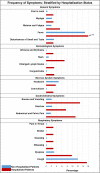A retrospective cohort study of 12,306 pediatric COVID-19 patients in the United States
- PMID: 33986390
- PMCID: PMC8119690
- DOI: 10.1038/s41598-021-89553-1
A retrospective cohort study of 12,306 pediatric COVID-19 patients in the United States
Abstract
Children and adolescents account for ~ 13% of total COVID-19 cases in the United States. However, little is known about the nature of the illness in children. The reopening of schools underlines the importance of understanding the epidemiology of pediatric COVID-19 infections. We sought to assess the clinical characteristics and outcomes in pediatric COVID-19 patients. We conducted a retrospective cross-sectional analysis of pediatric patients diagnosed with COVID-19 from healthcare organizations in the United States. The study outcomes (hospitalization, mechanical ventilation, critical care) were assessed using logistic regression. The subgroups of sex and race were compared after propensity score matching. Among 12,306 children with lab-confirmed COVID-19, 16.5% presented with respiratory symptoms (cough, dyspnea), 13.9% had gastrointestinal symptoms (nausea, vomiting, diarrhea, abdominal pain), 8.1% had dermatological symptoms (rash), 4.8% had neurological (headache), and 18.8% had other non-specific symptoms (fever, malaise, myalgia, arthralgia and disturbances of smell or taste). In the study cohort, the hospitalization frequency was 5.3%, with 17.6% needing critical care services and 4.1% requiring mechanical ventilation. Following propensity score matching, the risk of all outcomes was similar between males and females. Following propensity score matching, the risk of hospitalization was greater in non-Hispanic Black (RR 1.97 [95% CI 1.49-2.61]) and Hispanic children (RR 1.31 [95% CI 1.03-1.78]) compared with non-Hispanic Whites. In the pediatric population infected with COVID-19, a substantial proportion were hospitalized due to the illness and developed adverse clinical outcomes.
Conflict of interest statement
Dr. Kuranz is an employee of TriNetX, Inc, Cambridge, MA (USA). None of the other authors had any conflicts of interest or financial disclosures to declare.
Figures
References
-
- American Academy of Pediatrics and Children’s Hospital Association. Children and COVID-19: State Data Report (Version 9/17/20). https://services.aap.org/en/pages/2019-novel-coronavirus-covid-19-infect.... Accessed 26 Sep 2020.
-
- The COVKID Project (Coronavirus in Kids Tracking and Education Project). https://www.covkidproject.org/. Accessed 8 April 2021.
Publication types
MeSH terms
Grants and funding
LinkOut - more resources
Full Text Sources
Other Literature Sources
Medical
Miscellaneous




